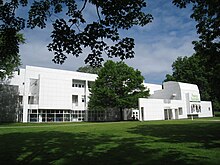Hartford International University for Religion and Peace
 | |
Former names | Hartford Theological Seminary Hartford Seminary Foundation |
|---|---|
| Type | Theological college |
| Established | 1833 |
| Affiliation | Non-denominational |
| President | Heidi Hadsell |
| Location | , , United States 41°46′12″N 72°42′27″W / 41.7699°N 72.7076°W |
| Website | www.hartsem.edu |
| File:Hartford Seminary.svg | |
Hartford Seminary is a non-denominational theological college in Hartford, Connecticut.
History
Hartford Seminary's origins date back to 1833 when the Pastoral Union of Connecticut was formed to train Congregational ministers.[1] The next year the Theological Institute of Connecticut was founded at East Windsor Hill, Connecticut. The institution moved to Hartford in 1865 and officially took the name Hartford Theological Seminary in 1885.[1] The Bible Normal College affiliated with the seminary in 1902 and changed its name to Hartford School of Religious Pedagogy.[2] The Kennedy School of Missions became another affiliated activity,[2] originally organized by the Seminary as a separate organization in 1911. In 1913, these three endeavors were combined.[1] In 1961, the entities were legally merged and adopted the new name Hartford Seminary Foundation, which was used until 1981, when the current name came into use.[1]
The Hartford Seminary Foundation published the Hartford Quarterly (originally named Bulletin - Hartford Seminary Foundation) from 1960 to 1968.[3]
Hartford Seminary began to offer niche concentrations in Christian-Muslim dialogue in 1972, and in 1990 Hartford Seminary officially claimed non-denominational status.[4] On Jan. 1, 2018, the Hartford Seminary joined the Boston Theological Institute (BTI), which is the largest theological consortium in the world.
Hartford campus
When the seminary moved to Hartford in 1865, it was at first located in the area now occupied by buildings of the Wadsworth Atheneum. In the 1910s, it planned a dedicated new campus on Hartford's west side, south of Elizabeth Street. Construction was delayed by World War I, and a handsome campus of Collegiate Gothic Revival buildings was constructed in the 1920s. Surviving elements of this construction phase were used by the seminary until 1981, and currently constitute the campus of the University of Connecticut School of Law.[5] The present main seminary building, designed by architect Richard Meier, was completed in 1981,[1] replacing several buildings demolished from the initial building phase. The seminary also continues to occupy several adjacent buildings that have historically been part of its campus. These, as well as the law school, were listed on the National Register of Historic Places in 1982, primarily for their architecture.[5]
Academics

Hartford Seminary is centered on two academic centers: the Hartford Institute for Religion Research[6] and the Duncan Black Macdonald Center for the Study of Islam and Christian-Muslim Relations. The seminary offers certificate programs and graduate degrees, including the only accredited Islamic chaplaincy programs.[7]
The Muslim World Publication
Hartford Seminary has been home to the academic journal The Muslim World since 1938. The journal was founded in 1911.[8]
Notable alumni

- Akaiko Akana, first pastor of Hawaiian ancestry at Kawaiahaʻo Church
- Fred Hovey Allen, clergyman and author, made first photogravure plates in U.S.
- Thomas L. Angell, scholar at Bates College
- Yahya Hendi, Georgetown University Muslim chaplain, Named one of the World's Most Influential Muslims, 2012.[9]
- Fenwicke Holmes, Religious Science leader
- Charles H. Kraft, evangelical Christian apologist
- Vergel L. Lattimore, professor at the Methodist Theological School in Ohio
- Richard T. Nolan, Episcopal Church/USA canon, writer, professor of philosophy and religious studies emeritus
- Beverly Daniel Tatum, President, Spelman College
- Andrew Young, pastor, mayor of Atlanta, U.S. Congressman, UN ambassador, President of the National Council of Churches USA, and member of the Southern Christian Leadership Conference (SCLC)
- Henry Allan Gleason Jr, linguist
- Asnage Castelly, A Haitian-American wrestler who competed for Haiti at the 2016 Summer Olympics in the 74 kg freestyle competition.
- Yvonne Y. Haddad, Professor of the History of Islam and Christian-Muslim Relations at Georgetown University
- Dr. Clayton R Maud, First Baptist Church of New Market N.J.
References
- ^ a b c d e "History of Hartford Seminary". Hartford Seminary. Retrieved 16 February 2012.
- ^ a b Rines, George Edwin, ed. (1920). . Encyclopedia Americana.
- ^ "The Hartford Quarterly". Johns Hopkins University Libraries.
- ^ Hartford Seminary, Our Story, hartsem.edu, USA, Retrieved December 17, 2017
- ^ a b "NRHP nomination for Hartford Seminary Foundation". National Park Service. Retrieved 2017-06-20.
- ^ "Hartford Institute for Religion Research". hirr.hartsem.edu. Retrieved 2018-02-12.
- ^ "Islamic Chaplaincy Program | Hartford Seminary". Hartsem.edu. Retrieved 2012-12-15.
- ^ "The Muslim World Journal | Hartford Seminary". Hartsem.edu. Retrieved 2012-12-15.
- ^ "Imam Yahya Hendi". The Muslim 500: The World's Most Influential Muslims. Royal Islamic Strategic Studies Centre. Retrieved December 13, 2012.
External links
- Official website
- . Collier's New Encyclopedia. 1921.
- . New International Encyclopedia. 1905.
- Hartford Seminary
- Educational institutions established in 1833
- Educational institutions established in 1913
- Education in Hartford, Connecticut
- Seminaries and theological colleges in Connecticut
- Universities and colleges in Hartford County, Connecticut
- 1833 establishments in Connecticut
- V-12 Navy College Training Program
- School buildings on the National Register of Historic Places in Connecticut
